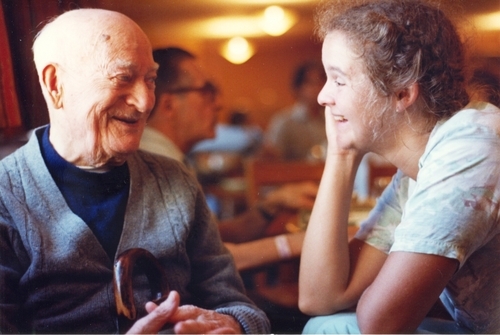Ladbury, Robert G.: my Air Force recollections (February 15, and 23, 2005)
Rank: Flight Lieutenant.
Interviewer: Nicks, Jennifer
ABSTRACT: Flight Lieutenant Robert Ladbury Royal Canadian Air Force (Cassette 1) Track 2: General discussion on DFC's. Track 3. Reasons for enlisting. Learned to fly Tiger Moths in 1939, waited for call up after war broke out. Track 4: On application he stated that he had finished high school (he had not). December 1st moved to London to Air Crew Receiving Centre, underwent all kinds of tests. Sent to grading school - this was to decide who was to become a pilot. He was found suitable as pilot material and was sent to Canada to train on Tiger Moths. Went solo after just 7 hours, his first flight was in 1942. (7 minutes) Fighter activity was in Russia. Trained on Anson's (bomber command) at Service Flying School. Went back to England in June 1943. Many pilots were lost during training. Went on BAT, (Beam Approach Training) course, flying Tiger Moths with BAT, learning how to fly an aircraft with Beam approach. Description of further flight training and elementary computers (20 minutes) He learned to fly Sterling's, biggest aircraft of its time. Required an engineer on crew as everything was electrical. All had to sign disclaimer for flying Sterling's. (32 minutes) Further description of the "Suicidal Sterling". Attended ground school, then 14 hours on Lancaster's. Ladbury was assigned to an Australian squadron, 460 Squadron at Benbrook. Trained from 1 December 1941 until April 1944. (39 minutes) Description of mess. Went to bomb in France. When they returned of the four RAF crews only one remained. Two Dutch crews were still there. (45 minutes) Untrained in radar though it was used in operations. Posted to 100 Squadron. Reposted to new unit to do Pathfinder duties. Did not know D-Day was coming up. Description of Pathfinder duties. (Cassette 2 ) Track 1: Briefings Track 2: Description of mess life at Benbrook. Went to special operations in France on full moons to bomb railway yards. Bomber Command pilots who successfully completed their tours, hit most of their targets, received a DFC. When finished he became a test pilot rather than an instructor. Discussion of morale which remained high. Lack of Moral Fibre, only knew of one person who lost his nerve. (28 minutes) Discusses his crew. Observations on the bombing campaign, he felt it went on too long, by October of 1944 they were bombing already bombed out targets. Further discussion of life in Benbrook and their relationship with the community. Track 3: Did not work Track 4: Discussion of night fighting and further reference materials (see reading list). (Cassette3) Track 1: Description of runways and emergency equipment. All went to Thetford for a battle course and taught unarmed combat. They practiced dummy runs to know how to escape. (7 minutes)They were dropped about ten miles out of the city and left to find their own way back. His particular group burglarized a hospital because there was food inside the window. Track 2: The pilot was held responsible for their crew (more important than rank). On some occasions higher-ranking officers were taken in their aircraft. Never a problem between rank and branches of the service. Track 3: All materials were donated to the Lancaster Museum in Nantun. Track 4: FIDO; three pipes on either side of the runway that ran the length of the runway full of gasoline heat would be used to disperse fog used a number of times. Thousands of gallons of gasoline provided a tremendous inferno. F/Lt. Ladbury's recommended readings to learn more about Lancaster's and Bomber Command: Middlebrook, Martin. The Nuremberg Raid: 30-31 March 1944. (London: Cassell & Co. {Cassell Military Paperpack series} 1980). Peden, Murray. A Thousand Shall Fall. (Canada: Canada's Wings Inc. 1979) Pearce, F/Lt. David H (DFC). Dark Skies and Dead Reckoning. (Victoria Australia: Coal Country Printers Pty Ltd. 2000) Garbett, M. and B. Goulding. Lancaster. (London: The Promotional Reprint Company. 1997) (All of F/Lt. Ladbury's materials can be found in the Nantun Lancaster Museum)
Interviewee: Ladbury, Robert G.
An interview/narrative of Robert Ladbury's experiences during World War II. Flight Lieutenant Ladbury served with the Royal Canadian Air Force. Interview took place on February 15 and 23, 2005.
- In Collection:
- 5 sound recordings (MP3)
- 48.4359, -123.35155
- 52.16045, -0.70312
- Three original audio cassettes ; 3 digital audio MiniDiscs in Special Collections.
- Canadian Military Oral History Collection
- LRG_439
- Special Collections Finding Aid: https://search.archives.uvic.ca/military-oral-history-collection
- September 24, 2012
- Digital sound recording in .wav format at 16 bits and 44 kHz. In .mp3 format at 56 kbps and 24 kHz. Digitized by JF, technical and cataloguing metadata provided by JF and JP. Interview migrated to digital format for UVic Special Collections in 2012. Migration metadata by KD and MT.
- Rights
- This interview has been posted with the understanding that it may be used for research purposes only. Should the interviewee or their heirs have any objections to this interview being accessible on the Internet, it will be removed promptly. Contact UVic Special Collections for permission if using for other than research purposes: speccoll@uvic.ca
- DOI
| Thumbnail | Title | Date Uploaded | Actions |
|---|---|---|---|
|
|
SC141_MilitaryOralHistory_GenericThumbnail |
|
|

|
Ladbury_R_0439_01.mp3 |
|
|

|
Ladbury_R_0439_02.mp3 |
|
|

|
Ladbury_R_0439_03.mp3 |
|
|

|
Ladbury_R_0439_04.mp3 |
|
|

|
Ladbury_R_0439_05.mp3 |
|